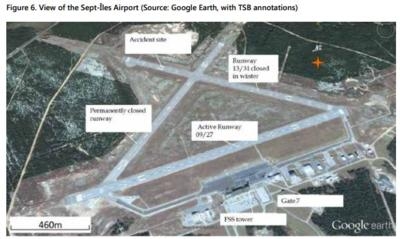Thu, Aug 06, 2015
Deviation From Approved Procedure During Training Flight Led To Accident
The Transportation Safety Board of Canada (TSB) has published its investigation report (A13Q0021) into an accident involving a helicopter training flight at the Sept-Îles Airport on February 3, 2013. The pilot instructor sustained serious injuries and the 2 pilots in training sustained minor injuries. The helicopter was heavily damaged.

The Eurocopter AS350 BA, operated by Héli-Excel Inc, was practicing various types of landings in unprepared areas. The aircraft then headed to the Sept-Îles Airport to undertake various simulated emergency exercises. At 0959 Eastern Standard Time, as the helicopter began its third hydraulic systems failure exercise, the flight instructor flew a short pattern at low altitude and low speed without hydraulic power. In the moments following the start of the final approach, the cyclic control stick moved sharply forward and to the left. The flight instructor gripped the cyclic stick to try and re-establish level flight. The main rotor blades struck the runway, and the aircraft came to a stop on its left side.
The investigation found that the approved procedure to complete this maneuver was not followed. As a result, the helicopter's flight profile deviated from the flight profile recommended by the manufacturer when the hydraulic system is depressurized. The investigation also found that in the absence of specific instructions for pilots regarding restoration of hydraulic pressure in the event of deviation from the flight profile, there is a risk that pilots will not be able to re-engage the hydraulic system while applying considerable effort to the helicopter controls.
The investigation made some other significant findings as to risk. First, the TSB has documented a number of cases where wearing a helmet would likely have reduced or prevented pilot injuries. Therefore, helicopter pilots who do not wear helmets are at increased risk of incapacitation, serious injuries or loss of life in the event of an accident. Secondly, the investigation revealed that there was no coordination of the emergency response. When emergency vehicles drive on an active runway without coordination between the airport operator and emergency response units, and with no means of communicating with the flight service station, there is a risk of collision on the runway.
(Image provided by TSB)
More News
He Attempted To Restart The Engine Three Times. On The Third Restart Attempt, He Noticed That Flames Were Coming Out From The Right Wing Near The Fuel Cap Analysis: The pilot repor>[...]
Make Sure You NEVER Miss A New Story From Aero-News Network Do you ever feel like you never see posts from a certain person or page on Facebook or Instagram? Here’s how you c>[...]
From 2009 (YouTube Edition): Leading Air Show Performers Give Their Best Advice for Newcomers On December 6th through December 9th, the Paris Las Vegas Hotel hosted over 1,500 air >[...]
Aero Linx: NASA ASRS ASRS captures confidential reports, analyzes the resulting aviation safety data, and disseminates vital information to the aviation community. The ASRS is an i>[...]
“For our inaugural Pylon Racing Seminar in Roswell, we were thrilled to certify 60 pilots across our six closed-course pylon race classes. Not only did this year’s PRS >[...]
 NTSB Final Report: Rutan Long-EZ
NTSB Final Report: Rutan Long-EZ ANN FAQ: Turn On Post Notifications
ANN FAQ: Turn On Post Notifications Classic Aero-TV: ICAS Perspectives - Advice for New Air Show Performers
Classic Aero-TV: ICAS Perspectives - Advice for New Air Show Performers ANN's Daily Aero-Linx (06.28.25)
ANN's Daily Aero-Linx (06.28.25) Aero-News: Quote of the Day (06.28.25)
Aero-News: Quote of the Day (06.28.25)



